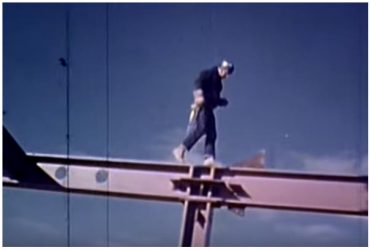
John Bleasby
“Look, ma! No harness!”
Canadian ContractorWorking at heights has changed since the CN Tower was topped off in 1975
It was another era: 1975. Iron workers, over 1,500 feet in the air atop the CN as the final antenna sections were placed by helicopter, operate in defiance of current working at heights requirements. No harnesses! Ah! Those were the days!
Take a short trip back in time
Got 30 minutes? Watch a remarkable film that chronicles the final construction of this engineering marvel. Watch the giant Sikorski helicopter Olga lift pieces into place with precision, 1,500 feet about the ground. Listen to a musical soundtrack that ranges from Stars Wars bravado to improvised jazz and early electronic warbling. In those days, even a construction documentary was a work of art, however kitschy.
CLICK HERE to watch the video.

This screen shot from the CN Tower video shows an unharnessed worker light-footing across beam, 1,500 feet above the ground.
However, the most remarkable aspect is the complete, literally complete, absence of safety harnesses on any worker seen on camera. It’s ironic when one hears to dulcimer tone of the narrator stating, “Safety is important on any construction project, and on this one it could be a matter of life or death!”
Industry-wide hesitancy towards safety still exists
Although safety regulations exist in all provinces under Occupational Health and Safety legislation, there continues to be reluctance on the part of many contractors, large and small, to observe the rules consistently. As reported in Canadian Occupational Safety magazine last fall, Paul Carolan, a safety professional with the government of Nunavut, speaking at the Canadian Society for Safety Engineering (CSSE) conference in Halifax in September 2017, said, “The inconsistent safety landscape across Canada makes for a difficult environment for the regulation of the safety profession. There is a hesitancy and it’s a significant hesitancy to say, ‘Are we ready?’ And my view is we’re not, just yet.”
The magazine goes on to note, “The lack of a unified, national approach is a major hindrance to achieving this status. There are 14 different acts/codes/regulations for safety across Canada. Even the terminology is not agreed upon — something that surprised Carolan when he moved to Canada from Ireland.”
Did the iron workers really wear no harnesses?
According to the trade magazine Wireless Estimator, “If an iron worker did wear a harness, they were tied off at the back and the harness had no leg straps. If they fell, the worker would most likely fall out of the harness.” By the way, the CN Tower workers were, according to Wireless Estimator, paid $8 per hour back in the mid-70s, the equivalent of $42 per hour or $1,680 per week plus overtime in today’s dollars.

Today, thrill-seekers can harness up and lean slightly over the edge of the observation deck roof.
Did anyone die building the CN Tower?
Yes. There is one reported death, but not from a fall. A worker died when struck by a piece of falling plywood, something that his hard hat was meant to mitigate. Notably, all workers in this 30-minute film are seen wearing hard hats, and properly.
Today, safety regulations, including working at heights, require training and supervision all on work sites. Could the iron workers have operated under today’s regime? They would have had to have found a way somehow, a way that would allow them the freedom of mobility required for their highly complex and precise work.
Got feedback? Make your opinion count by using the comment section below,
or by sending an email to:
JBleasby@canadiancontractor.ca
Follow John on Instagram and on Twitter for notifications about his latest posts

![]()
Advertisement
Print this page

Safety is a personal responsibility. Your supervisor cannot climb a ladder for you.
If an Ontarian were to read the current rules or discuss them with an MTO inspector, they would realize that it is impossible and potentially illegal to climb a ladder in order to affix a “D-ring” to a building.
The make-work project that is Canada’s “safety profession” does only two things: first, creates more government jobs making another Hoover Dam out of rules & red tape, and second, impedes the ability of competent construction professionals to carry out basic, albeit risky tasks.
It should also be mentioned that the bizarre convolution of safety rules provides plenty of regulatory loop holes for the insurance industry (a major donor to Ontario’s political parties) and the WSIB to reneg on their policy holders when accidents do happen.